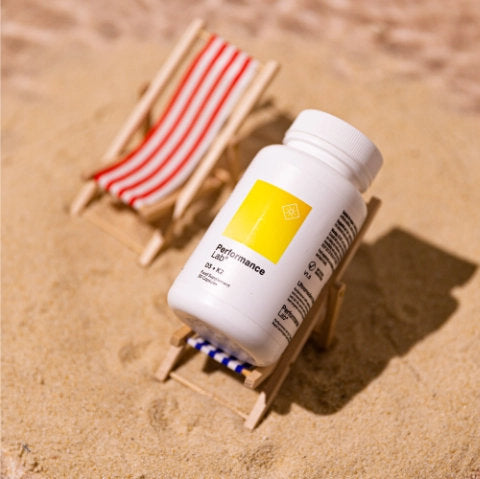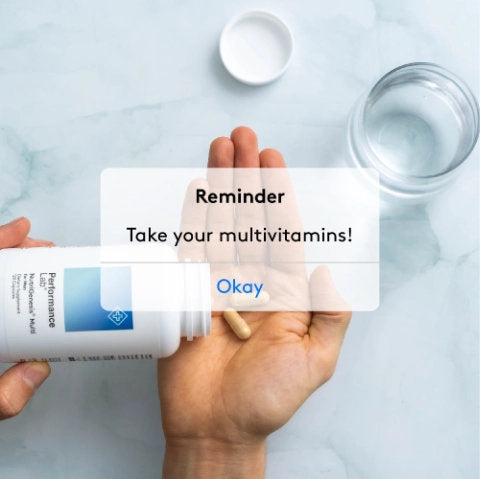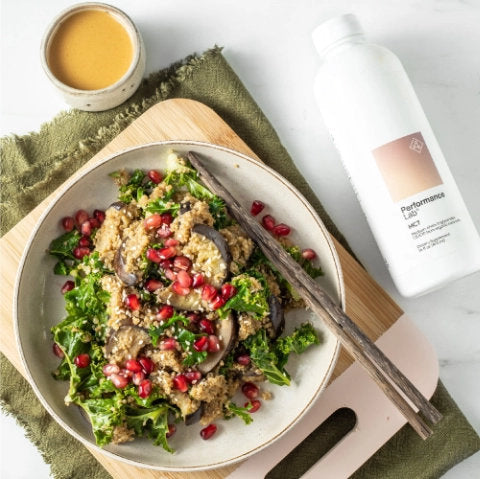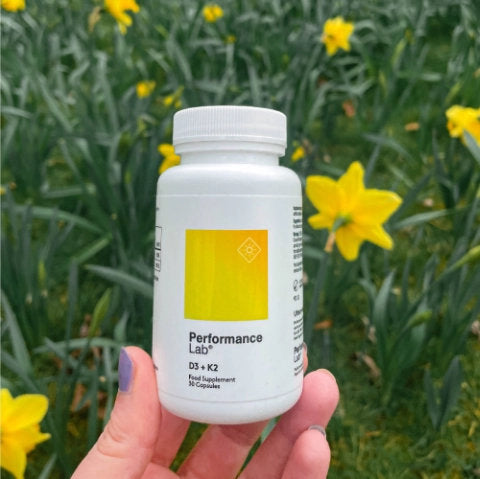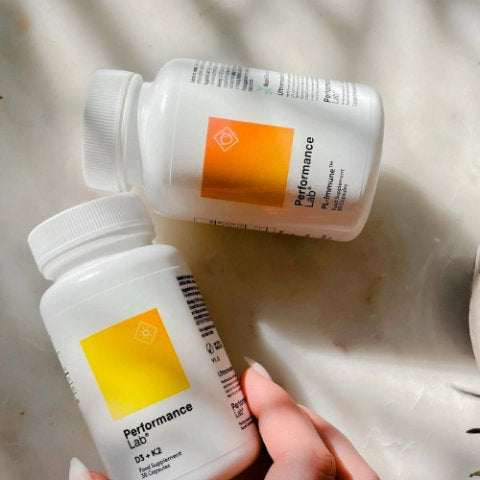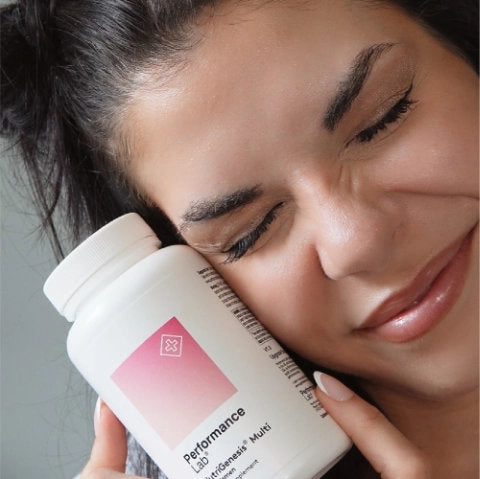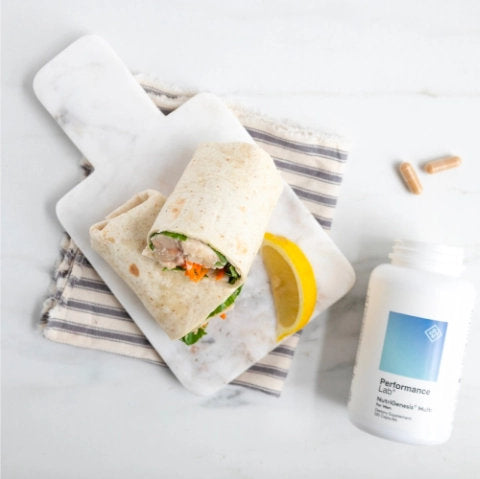Golfer’s elbow, tennis elbow, runner’s knee—though we typically attribute health and fitness to athleticism, there are plenty of aches and pains uniquely associated with athletic activity as well.
Not to mention athlete’s foot …but we won’t get into that here.
For competitive athletes and high-intensity exercisers, joint pain is all part of the game. Virtually everyone committed to an active lifestyle has experienced some form of injurious muscle strain or stiff joint pain.
However, this doesn’t mean that there’s nothing an athlete can do to soothe their achy joints and to protect against more serious, long-term joint degradation.
Joint pain is part of the game, but it’s not something you have to necessarily deal with on game-day, so long as you take special measures to protect your joints.
In addition to stretching and selective strength-training, not to mention getting proper rest and recovery, one of the best ways to support your joint health and performance is to take daily joint support supplements.
For athletes and exercisers, Performance Lab® Flex supplies the best combination of joint support ingredients, each of which target a specific bio-pathway for improved joint health. Here’s a quick glance at each ingredient:
List of the Top Joint Supplements for Athletes
- Boswellia Serrata – traditional botanical supplying bioactive AKBA that soothes inflamed joints and combats joint-destructive 5-LOX enzymes.
- Turmeric (Curcumin) – popular Ayurvedic spice rich in curcuminoids, a class of joint-protective antioxidants that block harmful COX-2 enzymes.
- Glucosamine Sulfate – a foundational amino sugar building-block required for cartilage cells, connective tissues, and joint-lubricating synovia.
- Chondroitin Sulfate – often paired with glucosamine, this complex molecule helps keep cartilage well-hydrated, cushy, and shock-absorbent.
- Methylsulfonylmethane (MSM) – a key structural nutrient required to form collagen, glucosamine, chondroitin, and other joint-essential proteins.
Taken individually, each of these ingredients contribute to a particular aspect of joint health and flexibility. However, combined, these ingredients work even better by comprehensively targeting all joint health biopathways for optimal athletic performance.
For a deeper breakdown of these supplements, including the best all-in-one joint supplement stack Performance Lab® Flex, jump below to the “Best Joint Supplements for Athletes” section.
Otherwise, continue reading to learn more about the relationship between joint health and athleticism, starting with why your joints might be hurting when you exercise.
Why Do My Joints Hurt When I Exercise?
Let’s start here: not exercising at all is bad for the joints. In fact, in the long term, a sedentary lifestyle is worse for joint health than a highly active lifestyle.
Research has linked skeletal muscle wasting, a decrease in muscle mass due to lack of physical activity, to an increased risk of osteoarthritis (OA).
So, if exercise helps reduce the risk of joint issues, why the heck do my joints hurt so bad when I do exercise??
Obviously, if you roll your ankle while working out, you’re not going to question why your ankle now hurts when exercising.
However, joint pain and stiffness may gradually accumulate the more you exercise, especially if you’re exercising on a daily to near-daily basis.
There are several reasons why your joints might be hurting while working out:
- Inflammation: overexercising or failing to get adequate rest and recovery may result in an excess accumulation of inflammation in the joints, resulting in pain and stiffness and gradual deterioration.
- Rapid Hypertrophy: quickly increasing your muscle mass can be tough on the joints, namely the knee, as anyone who’s experienced Osgood-Schlatter during their growth spurt youth can attest.
- Poor Form and Posture: exercising with poor form, say while squatting, can throw your weight-load off-balance, resulting in an excess concentration of stress on your hips, knees, back, and so on.
- Dehydration: anyone who’s supplemented creatine, which increases one’s risk of dehydration, may be familiar with dehydration-related joint pain, as the dehydrated connective tissues in the joints painfully tighten up.
- Failure to Stretch: speaking of tight tissues, stretching is key to preventing muscle knots and overall tightness associated with joint pain, as well as general muscle aches and pains.
It’s well-known that rest and recovery are just as important to boosting your muscle and strength gains as exercise.
However, it’s also important to get enough post-workout rest for your joints to mitigate excess inflammation and stiffness.
This also means getting adequate post-workout hydration and nourishment, as well as a daily stretch, whether working out or not.
The Relationship Between Joint Flexibility and Stability
A strong, stable joint is important to sustaining ongoing high-intensity exercise and competition. So, too, is flexibility an important factor in athletic performance.
Yet, joint flexibility and stability are antagonistic.
Simply put, the greater the flexibility, the less stable the joint; and vice versa.
This makes intuitive sense, considering that when we think of “stable” we think of stiffness and sturdiness—i.e., the opposite of mobility and flexibility.
The relationship between flexibility and stability are generally affected by three things:
- Ligament Strength: the ligaments in the shoulder are more relaxed than those of hip, hence the greater range-of-motion with the shoulder than that of the hip. Though “weak” ligaments in certain joints may allow for greater flexibility, their risk of injury is greater than “strong” ligaments.
- Bone Shape: the shape of the bones within and around the joint officially set the limits of a joint’s range of motion—e.g., ball-and-socket joints, such as the shoulder, allow for a great range of motion, at the cost of decreased stability, whereas the knee and elbow only allow flexion and extension, at the cost of decreased flexibility.
- Musculature: the skeletal muscle within and around the joint also affect stability and flexibility; generally, an increase in muscle mass comes with an increase in stability and a decrease in flexibility, though increasing your tendon and ligament strength is required to sustain strenuous postures.
While balance between flexibility and stability is important, different sports have different demands.
Bodybuilders require greater muscle mass and joint stability than, say, gymnasts, who require a greater degree of flexibility and range-of-motion.
In either case, it’s important to support your overall joint health, including the connective tissues and bones within the joint, for optimal athletic fitness and performance.
Many athletes, from strength-trainers to endurance runners, enhance their flexibility, stability, and overall joint comfort by taking a daily joint support supplement.
Do Joint Supplements Work?
Okay, so athletes take joint support supplements, but do they actually work?
Well, of course, they do! Why else would athletes take them?
Though predominantly discussed in the context of elderly health care and age-related joint degradation, joint supplements can also significantly benefit athletes and exercisers by soothing overworked connective tissues and protecting against exercise-related oxidative stress and cartilage wear-and-tear.
Taken daily, an effective joint supplement may help prolong joint longevity while dealing with acute discomfort and stiffness.
But what distinguishes an effective joint stack from an ineffective one?
What Should Athletes Look for in a Top Joint Support Supplement?
Joint supplements work—or, rather, some joint supplements work.
Below, we’ll go through the best joint support ingredients to look for in a joint support supplement.
However, to distinguish an effective joint stack from an ineffective one, you’ll need to look for the following:
- Quality – highly potent, bioavailable ingredients with high absorption rates
- Quantity – a moderate amount of ingredients supplied at minimally effective doses
- Transparency – no proprietary blends to hide the ingredient dosages
- Cleanliness – no animal or shellfish-sourced ingredients
- Natural – no synthetics or artificial additives, sweeteners, colorants, etc.
- Safety – only well-researched ingredients with high safety ratings
Not to mention affordability—i.e., does the value match the price?
The note on shellfish-sourced ingredients is particularly important to joint supplements, which tend to supply ingredients with risky “fishy” origins.
There are plant-based alternatives to these ingredients and compounds that are generally cleaner and safer than their non-vegan counterparts.
Best Joint Supplements for Athletes
The joint is a complicated mechanism involving several interconnecting and overlapping tendons, ligaments, and other connective tissues.
Whereas some joint support ingredients assist with tendon and ligament strength, others focus on cartilage hydration and bone mineral nourishment.
Which is to say that no single joint ingredient may comprehensively support the joint alone. Instead, this requires a stack of joint support ingredients in a comprehensive all-in-one formula.
With that in mind, the best joint support supplement includes all of the following ingredients:
Boswellia Serrata
Extracted for many centuries in Asian and African traditional medicine, the resin of Boswellia serrata, a desert tree, is rich in bioactive boswellic acids, most notably AKBA (3-O-acetyl-11 keto-β-boswellic acid). As the most effective boswellic acid for joint health, AKBA seems to work by:
- Modulating the inflammatory response to soothe and protect joints;
- Blocking the 5-LOX enzyme that gradually eats away at cartilage;
- Reducing matrix metalloproteinase (MMP) enzyme that diminishes connective tissue strength and integrity.
In a systematic review and meta-analysis of Boswella serrata research, a group of researchers assessed data from seven clinical trials to determine Boswellia serrata’s efficacy as an anti-inflammatory agent for joint support. The researchers found that, based on the data, “Boswellia and its extract may be an effective and safe treatment option for patient with , and the recommended duration of treatment with Boswellia and its extract is at least 4 weeks.”
Best Boswellia Serrata for Athletes: AprèsFlex®
AprèsFlex® is an advanced Boswellia serrata extract that’s standardized to 20% AKBA for enhanced potency and efficacy. Compared to plain Boswellia serrata, AprèsFlex® Boswellia serrata extract has 52% greater absorption for a greater degree of reliable joint support.
Turmeric (Curcumin)
A popular food spice and a prized herb of the Ayurvedic health tradition, turmeric is today considered a superfood for its diverse range of health benefits largely attributed to this herb’s supply of bright yellow plant pigments called curcuminoids. Of these curcuminoids, curcumin is most associated with soothing and supporting joint tissues and flexibility, due to this compound’s effects on:
- Reducing joint-destructive oxidative stress (free radicals);
- Regulating COX-2, MMP, and AGEs (advanced glycation end-products);
- Supporting collagen synthesis and other structural joint proteins.
By simultaneously protecting against joint-diminishing enzymes while improving joint stiffness and comfort, turmeric is a great herb for joint pain relief and protection against future joint pains and aches.
Best Turmeric for Athletes: CurcuWIN®
CurcuWIN® is one of the go-to turmeric extract supplements for both joint health and cognitive health, and this is in large part due to this premium extract’s potent supply of 20% curcuminoids that are 46X more absorbable than standard turmeric powder.
Glucosamine Sulfate
One of the go-to supplements for joint pain, glucosamine is an amino sugar naturally found in connective tissues that surround and cushion the joint, including cartilage, tendons, and ligaments, as well as the joint-lubricating synovial fluid.
For joint support, glucosamine primarily works by supporting the chondrocyte cells within joints that are responsible for repairing and regenerating cartilage. Additionally, glucosamine’s support of synovial fluid helps keep joint movement smooth and well-lubricated, protecting against the uncomfortable bone-on-bone grind that accompanies both cartilage and synovia deterioration.
Best Glucosamine for Athletes: Glucosamine Sulfate 2KCl
Most glucosamine is sourced from shellfish, yet few know that there’s a plant-based alternative: glucosamine sulfate 2KCl sourced from corn. Corn-sourced glucosamine sulfate is not only cleaner than shellfish-sourced glucosamine but it’s also superior to other glucosamine forms for its addition of sulfate, which is an essential “building block” for healthy joints and bones.
Chondroitin Sulfate
Often paired with glucosamine, chondroitin is a large, complex molecule that weaves through the extracellular matrix of cartilage to give it a negative water-absorbing charge. When chondroitin levels decline, cartilage dries up, making it less cushy and shock-absorbent.
Supplementing chondroitin can benefit joint health by maintaining cartilage hydration for greater shock-absorbing performance, supporting healthy collagen production, and promoting the activity of chondrocyte cells for enhanced cartilage growth and repair.
Best Chondroitin for Athletes: Phytodroitin™
Phytodroitin™ is a plant-based alternative to chondroitin, derived from seaweed extracts. Traditional chondroitin is often sourced from animal products like shark cartilage, pork byproducts, or bovine connective tissue. Phytodroitin™ offers a safe and sustainable substitue, free from controversial origins.
Methylsulfonylmethane (MSM)
An organic form of sulfur, methylsulfonylmethane (MSM) is a key structural micronutrient required for the formation and maintenance of collagen, glucosamine, chondroitin, and other joint-essential proteins. That MSM assists with the activities of glucosamine and chondroitin make it a smart complement to any joint formula, namely by providing the raw “building block” sulfur needed to naturally produce these proteins.
Best Methylsulfonylmethane (MSM) for Athletes: OptiMSM®
The world’s purest MSM, OptiMSM® is the only GRAS-designated (Generally Recognized As Safe) MSM. Made in the USA with a proprietary multi-stage distillation process, OptiMSM® yields greater purity, quality, and consistency than standard MSM supplements.
Performance Lab® Flex: Most Effective Joint Support for Athletes

Delivering the best all-in-one flex support formula, Performance Lab® Flex is a must-have stack for the high-intensity athlete and active busybody.
Performance Lab® Flex’s ultramodern ingredients are curated and combined to address both short-term and long-term joint demands, simultaneously soothing already achy joints while protecting against future pains and injuries.
With a two-pronged approached involving:
- Soothing Botanicals for Natural Joint Comfort
- Maintenance Support for Healthy Joint Structure, Performance Lab®
Get the Best Deal on Performance Lab® Flex Here
Key Benefits
- Flexibility –Flex helps restore high-performance flexibility and comfort by reducing excess inflammation and stiffness.
- Strength – Flex nourishes connective tissue integrity and bone mineral density for increased joint resilience under pressure.
- Lubrication – Flex supports healthy synovial fluid production and effectiveness for smooth, well-lubricated range of motion.
- Protection – Flex protects against cartilage-eating enzymes and joint-damaging oxidative stress and inflammation for greater joint longevity.
- Shock Absorption – Flex helps keep cartilage tissue cushy and well-hydrated for optimal shock absorption, most notably in the knees and hips.
By targeting multiple joint health and flexibility pathways, Performance Lab® Flex optimizes virtually all aspects of joint integrity for a boost on athletic performance.
What’s more, Performance Lab® Flex achieves all these benefits with a 100% natural formula using all-natural ingredients and a plant-based formula delivery system: NutriCaps®.
Key Features
Quality matters when it comes to joint supplements, especially considering how many have questionable “fishy” shellfish-sourced origins.
By avoiding all fish and animal byproducts, using only plant-based ingredients and capsules, Performance Lab® Flex works with a minimal risk of side effects or negative ingredient interactions.
A few key formula highlights:
- Extensively Researched – each ingredient is backed by clinical human research demonstrating significant joint support benefits.
- Synergistic Combination – these ingredients also work better together than alone by targeting the same biopathways via unique bioactivities.
- Safe and Effective – Flex works without any harsh synthetics or artificial additives that upset the stomach or disrupt joint-essential proteins.
Matching the quality and cleanliness of Flex’s ingredients, Performance Lab® Flex’s NutriCaps® are prebiotic-cultivated capsules constructed out of fermented tapioca (pullulan). Safe for long-term daily use. No upset stomach or other adverse effects.
Like all Performance Lab® products, Performance Lab® Flex uses clinically effective doses along with premium, potent ingredient forms for maximum efficacy.
Supplement Facts: CurcuWIN® Turmeric (20% Curcuminoids), AprèsFlex® Boswellia serrata (20% 3-0-acetyl-11-keto-β-boswellic acid ), Glucosamine Sulfate 2KCL, Mythocondro® Chondroitin Sulfate, OptiMSM® Methylsulfonylmethane.
Summary
Pre-workouts, creatine, BCAAs, proteins—these are the typical types of supplements favored by athletes and exercisers.
However, few consider the importance of joint health and flexibility, let alone realize that joint health and flexibility can be effectively supported with a daily flex support supplement.
Like skeletal muscle tissue, joint connective tissues require significant post-workout/post-competition repair and recovery.
Much of basic sports nutrition can help restore and replenish overworked joints. Yet, as many athletes know, this often isn’t enough to mitigate achy, stiff joints.
This is where Performance Lab® Flex Joint Support for Athletes comes into play.
- By soothing and replenishing stiff, inflamed, depleted joint tissues, Performance Lab® Flex offers daily flexibility support for always competition-ready joint performance.
The idea isn’t to wait until the joint pain gets so severe that you must take action, potentially lowering your competitive performance or exercise efficiency in the meantime, but rather to start taking Flex now to drastically lower your risk of severe joint pain.
Whereas most joint stacks focus exclusively on elderly joint care, Performance Lab® Flex tackles both athletic joint issues and age-related wear-and-tear.
And with a totally synthetic-free, plant-based formula, Performance Lab® Flex is legal and safe to use by athletes of all sports and dietary lifestyles.
References
- Shorter E et al. Skeletal Muscle Wasting and Its Relationship With Osteoarthritis: a Mini-Review of Mechanisms and Current Interventions. Curr Rheumatol Rep. 2019; 21(8): 40.
- Sokolove J, Lepus CM. Role of inflammation in the pathogenesis of osteoarthritis: latest findings and interpretations. Ther Adv Musculoskelet Dis. 2013 Apr; 5(2): 77-94.
- Perolat R et al. Facet joint syndrome: from diagnosis to interventional management. Insights Imaging. 2018 Oct; 9(5): 773-789.
- Cramer H et al. Postural awareness and its relation to pain: validation of an innovative instrument measuring awareness of body posture in patients with chronic pain. BMC Musculoskelet Disord. 2018; 19: 109.
- Cleary MA et al. Dehydration and Symptoms of Delayed-Onset Muscle Soreness in Normothermic Men. J Athl Train. 2006; 41(1): 36-45.
- Batista LH et al. Active stretching improves flexibility, joint torque, and functional mobility in older women. Am J Phys Med Rehabil. 2009 Oct; 88(10): 815-22.
- Micheo W et al. Basic principles regarding strength, flexibility, and stability exercises. PM R. 2012 Nov; 4(11): 805-11.
- Siddiqui MZ. Boswellia Serrata, A Potential Antiinflammatory Agent: An Overview. Indian J Pharm Sci. 2011 May-Jun; 73(3): 255-261.
- Yu G et al. Effectiveness of Boswellia and Boswellia extract for osteoarthritis patients: a systematic review and meta-analysis. BMC Complement Med Ther. 2020; 20: 225.
- Hewlings SJ, Douglas SK. Curcumin: A Review of Its’ Effects on Human Health. Foods. 2017 Oct; 6(10): 92.
- Zhu X et al. Effectiveness and safety of glucosamine and chondroitin for the treatment of osteoarthritis: a meta-analysis of randomized controlled trials. J Orthop Surg Res. 2018; 13: 170.
- Henrotin Y et al. Chondroitin Sulfate in the Treatment of Osteoarthritis: From in Vitro Studies to Clinical Recommendations. Ther Adv Musculoskelet Dis. 2010 Dec; 2(6): 335-348.
- Vasiliadis HS, Tsikopoulos K. Glucosamine and chondroitin for the treatment of osteoarthritis. World J Orthop. 2017 Jan 18; 8(1): 1-11.
- Butawan M et al. Methylsulfonylmethane: Applications and Safety of a Novel Dietary Supplement. Nutrients. 2017 Mar 16; 9(3): 290.





